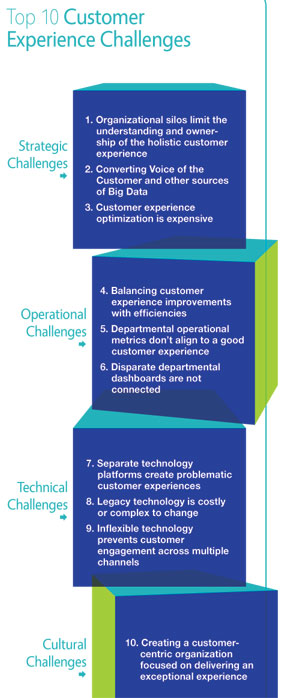If you want to differentiate your customer experience strategy, exceptionalism is the only option. A positive customer experience today is not enough. To stand out, you need to wow customers and deliver an exceptional experience, or they will simply move on.
Having all the pieces in place to create an exceptional experience can be a daunting task. Today's market sits at the center of a seismic shift in the relationships among people, apps, companies, and data. Mobile and cloud computing create disruption. Immediate, in-depth information is available and expected almost anywhere. Customers are fickle and have no long-term commitment to brands. Meanwhile, companies are tangled in legacy systems and cultures that can't respond effectively to today's demands in an enterprise-wide way. How can you prepare for the customer of the future when the present-day situation is less than optimal?
Many companies understand the need to create an exceptional customer experience, but find it difficult to deliver the promise. It might be talked about, but results are sparse. A May 2013 Temkin Group study, The State of Customer Experience Management, found that while most of the 200 organizations surveyed have an executive in charge of customer experience and significant programs being coordinated by a central team with dedicated staff, only 6 percent of companies have reached the highest levels of customer experience maturity.
There are a number of factors contributing to the business world's lack of customer experience excellence. But regardless of industry, senior leaders face similar strategic, operational, and technological challenges. We have outlined 10 top customer experience barriers faced by organizations today (see sidebar). Below are recommendations for how to break through the barriers in order to design and build a strong foundation for future customer experience excellence.

Strategic challenges
The first steps toward enterprise-wide customer experience optimization can be the hardest. Too often, great customer experience work is happening, but it's being done in a vacuum. Sure, your marketing team or salesforce may be doing great work to understand customers and be relevant with their interactions. But then what? Success achieved at a department or channel level does not go far enough to match the expectations of customers. In some cases, individual initiatives may actually counteract one another, causing more confusion than if nothing was done in the first place.
The lack of holistic customer experience ultimately impacts the brand. To gain a true understanding of your company, you must coordinate all customer interactions across the company to optimize the customer experience. Peppers & Rogers Group has defined five customer experience pillars to help companies align their customer-related strategies and activities across the enterprise:
1. Take action on Voice of Customer in real time
2. Facilitate consistent interactions
3. Create relevant experiences
4. Enable channel integration
5. Cultivate customer trust
At the front end, the right leadership and strategy is essential. Company leaders must set the customer-focused vision, and stay involved to make sure internal elements are aligned. A common, clear customer engagement strategy must exist across the enterprise that aligns with the organization's unique needs and implementation capabilities. Then, companies can design processes within individual business units that tie to broad company goals. The technology and infrastructure chosen must provide a single customer view and meet complex needs of the relationship according to the strategy. And finally, a commitment to change management and training ensures better alignment with the integrated strategic vision (see Figure 1). Strategy must guide all the pieces of the program, or else any customer initiatives will be in danger of reverting back to a series of disconnected, siloed initiatives.
Even before a customer experience strategy is put into place, it can be difficult to allocate the necessary resources up front. Optimization requires people, process, and technology changes over a considerable period of time. Often significant investment is needed. Many executives are content with the status quo simply because they view customer experience efforts as too costly to the pocketbook or daily business operations.
Yes, it can be hard to quantify customer experience improvements. But there is information out there that ties enhancements in customer experience to long-term financial strength. The reality is that investment now pays off later. For example, research from Watermark Consulting and Forrester Research tracked the five-year stock performance of companies on Forrester's Customer Experience Index. Even during the recession years of 2007-2012, customer experience leaders averaged a 43 percent gain in stock performance, besting customer experience laggards, who averaged a 34 percent decrease in stock price.
How can companies decide what investments will enable them to be customer experience leaders? Before money is spent, it's necessary to know which customer programs will net the best return. We recommend implementing a strategic value map to help visualize potential ROI and prioritize initiatives. The map will detail how specific initiatives will impact specific areas of the business, and ultimately, customer value. The ability to show exactly how certain initiatives will affect the customer experience is essential to gaining buy-in from budget owners (see Figure 2).
Operational challenges
Operationally, it's important to take an outside-in approach to customer interactions. At many organizations, customer experience improvements conflict with efficiency efforts. As a result, customer programs often take a back seat. While efficiencies are important, they don't tell the whole story. The best efficiencies may still result in a poor customer experience. Looking only at internal metrics and processes may not give the real picture of what customers experience.
Take the contact center, for example. It used to be that efficiency trumped all else when measuring success in that department. But now, a mix of internal and external metrics are coordinated to provide more of a balanced approach. According to Call Center Helper magazine, the top contact center metrics now include customer experience attributes such as associate quality scores, first call resolution, customer satisfaction, and Net Promoter Score alongside internal measurements including average handle time and utilization rates.
Again, this is where organizational alignment is key. Be sure that what's happening in one department doesn't come at the cost of another department. Success factors must be a mix of internal mechanics and customer-based output across the enterprise.
When sharing information with others, how you present the information is almost as important as what you present. It can be difficult getting stakeholders to understand the progress of the entire program across the business. Dashboards and scorecards often tend to be created and shared in silos. Alleviate the gap in customer understanding with a cohesive operational dashboard that is truly aligned to company goals (see Figure 3). Otherwise, departments are pitted against one another instead of working together. And keep scorecards and dashboards simple and actionable. An exceptional organization will keep the operational focus on what is important to customers.
Technical challenges
Even the best laid plans will fail without the right tools and technologies to implement them successfully. A common technical challenge is that companies end up with a plethora of disparate customer systems. Instead of a coordinated technical strategy, companies often jerry-rig new tools and technologies to ones already in place, or have different systems for different functions that never connect with one another. This is because legacy systems are complex, and it's hard to rip them out and start over. While this may be a short-term solution, in the long run separate technology platforms will create problematic customer experiences, particularly as the number of interaction channels grows and coordination becomes more complicated (see Figure 4).
All too often, systems are built to meet the company's needs, not those of the customer. They are not integrated, and customers (and employees) end up having to navigate through multiple systems. As a result, companies often see inconsistent experiences across channels, unhappy customers, and potential customer defection.
There are tools out there that combine multiple siloed systems to create a single customer view. The goal is for everyone within the company to have access to the information they need, when they need it. Systems integrators are important, but whoever takes charge of the technical aspects of your customer experience must take an outside-in approach to create a ubiquitous, 360-degree view of clients and customers.
Securing the building blocks
Optimizing the customer experience in all areas is no easy task. Some companies have solved many of these challenges, while some need to start from scratch. Regardless of the tactics, remember that the ultimate goal is to overcome the barriers and align your business to the customer experience. Overall, it can be summed up in four simple steps:
1. Assess current tools, strategies, and capabilities.
2. Examine the end-to-end customer interactions through the eyes of the customer, then build customer-focused strategies and processes that fill in gaps to establish and maintain long-term, profitable customer relationships.
3. Build a sustainable customer engagement plan that aligns to the organization's overall strategy for the long term.
4. Define, design, and deploy the right technology to enable the strategy and processes.
What you do to complete these steps is up to you. With proper strategic alignment, customer-centric design, and the right technology in place, organizations will learn to execute an exceptional, frictionless customer experience through a connected enterprise, for both today and tomorrow.






